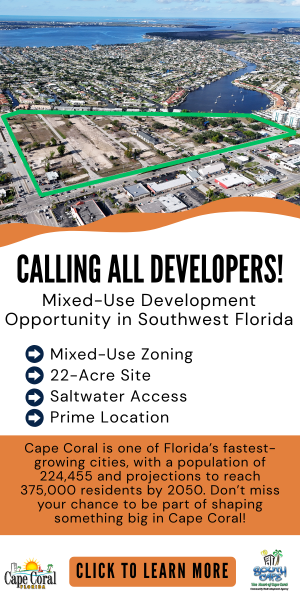Tee-Commerce: Acing the Golf-Course Conversion

With acres of open space in prime locations, abandoned golf courses can be ideal spots for infill warehouse and distribution facilities.
Developers seeking to create industrial space within densely populated communities are increasingly unlikely to find suitable acreage as unimproved land. E-commerce firms and other industrial users seek proximity to consumers, but the infill locations they desire for distribution centers often require demolition and the removal of existing structures before new development can begin.
Yet there is a sizeable supply of urban sites that offer developers a green slate of grassy meadows and gently rolling landscapes, often at the center of residential submarkets and along major transportation corridors. And in some cases, these large-acre tracts have reverted to lenders and may be available at attractive pricing.
This opportunity for developers lies in an ongoing correction in the supply of golf courses. The U.S. has 14,794 golf facilities, or 45 percent of the global supply, according to the National Golf Foundation (NGF), which tracks the industry. According to NGF, a 20-year run of construction of more 4,000 golf courses came to an end in 2006 when closures began to outnumber new course openings.
More than 200 U.S. courses closed permanently in 2017 while only about 15 opened. NGF projected a similar trend in 2018, and the correction is likely to continue. Considering the average golf course comprises 150 acres of land, it’s not surprising that developers of all property types, ranging from single-family and multifamily homes to mixed-use office and retail properties, are taking interest.
Yet in the current market, industrial is one of the strongest product types. And despite nearly 1 billion square feet of new inventory delivered in the past three years, according to Transwestern research, industrial demand continues to outpace supply.
From Golf Course to Distribution Center
One such site is under redevelopment in Lakeland, Florida, where Transwestern Development Co. and partner Crow Holdings Capital Real Estate are working on the largest speculative industrial project in the state’s history.
Bridgewater Distribution Center will provide as much as 1 million square feet of space, beginning with a 713,000-square-foot building that broke ground in January. To put that in context, of the 3.1 million square feet of industrial projects currently under development in Central Florida, the average building size is 136,000 square feet, according to Transwestern and CoStar.
It’s being marketed to e-commerce firms that can utilize the building’s 36-foot clear heights for racking, large truck courts and access to 19 million consumers within a two-hour drive. Prior to 2014, only one lease in the area measured 600,000 square feet or more; in 2014 and subsequent years, Central Florida has seen eight industrial leases of that size, including six deals with e-commerce users, according to project research completed for Bridgewater Distribution Center.
With a 117 million-square-foot inventory of industrial space, Central Florida’s vacancy rate at the end of 2018 was a scant 4.0 percent. That was unchanged from a year earlier but well below the 7.5-percent rate tracked in 2015. Limited availability has helped to support escalating rents: average rent in the area was $5.88 per square foot at the end of 2018, up 1.4 percent from a year earlier, and the average rent for new construction is $6.20 per square foot, according to CoStar.
The former Golf Club at Bridgewater was part of a massive mixed-use development, also called Bridgewater, and it rests on a reclaimed, open-pit phosphate mine that was filled in. A previous developer built the golf component in the 2000s to complement the high-end residential neighborhoods nearby. But after just a few years of operation, the course closed in 2009, soon after the financial crisis. Ownership of the 183 acres eventually reverted to the lender.
The site’s proximity to an adjacent business park and excellent access to Interstate 4 made it a good candidate for industrial use. At roughly the geographic center of Florida, tenants will be ideally positioned to transport goods throughout the state. They'll also be within a day’s drive of Charleston, South Carolina, Mobile, Alabama, and other regional destinations.
Transwestern’s experience in shepherding the project through rezoning and redevelopment offers a case study in golf course conversion, and it provides investors and developers a look at the advantages and potential hazards they might encounter if they undertake similar projects.
Court the Community
Golf course conversions deserve extra diligence when planning and communicating with area residents.
In many instances, access to local golf may have influenced homeowners’ choice of residence. If the same firm developed both the course and nearby homes, homebuyers may feel entitled to access the course as a promised amenity. Developers who take the time to learn how community members will likely react to a redevelopment proposal and take any concerns into account will have a greater chance of securing local approvals.
For Transwestern and Crow Holdings, rezoning was top of the agenda after placing the site under contract. The team worked with the city of Lakeland to create a development that would satisfy city leaders and address neighborhood concerns. City staff proved helpful in anticipating citizens’ apprehensions about the project and suggested compromises to help with the approvals process.
The final design included a number of concessions to the community, including wide setbacks and construction of a landscaped, earthen berm to shield residents from buildings and truck courts. City leaders approved the proposal and rezoned the site to a planned urban development for industrial use.
Look Beneath the Surface
Even a beautifully landscaped golf course can harbor environmental hazards sufficient to render a redevelopment infeasible. The longer a course was open, the more likely it was exposed to insecticides, fertilizers and other potentially harsh chemicals, which can linger in the soil.
Bridgewater only had a trace of caustic mineral deposits; if needed, they can be removed without reducing the property’s use. If a tract has high levels of certain contaminants, federal or state regulations could require more intensive remediation or deed restrictions to prevent uses such as daycare that might expose children to dangerous materials.
Soil can present other types of hazards that limit suitability for redevelopment. Topographic features built to support foot traffic and carts may not sustain buildings and vehicles. As in any industrial due diligence, a developer should conduct extensive geologic testing to determine soil composition and the expected cost of shoring up any weak spots to support anticipated loads.
As a former mining site, Bridgewater’s base was fill dirt rather than original strata. Testing showed the resultant mix is more than stable enough for an industrial park.
Water features deserve careful attention. Ponds at Bridgewater are protected wetlands, and it took 16 months of filing applications and working with the Army Corps of Engineers before they could be disturbed. A comprehensive solution involved creating high-quality and better-managed wetlands elsewhere on the site and the purchase of mitigation credits that went to support off-site wetlands management.
While a golf course conversion can present unique challenges, patience and creativity pay off. With land in high-density metros in short supply, the acres of open land available at even a single golf site constitute a worthwhile opportunity for the innovative developer.
Steve Kros is executive vice president of Transwestern’s Southeast logistics team.




